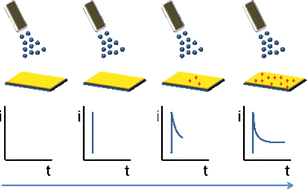Surface effects and electrochemical cell capacitance in desorption electrospray ionization†
Abstract
Time resolved measurements show that during a desorption electrospray ionization (

* Corresponding authors
a
Department of Chemistry, Purdue University, West Lafayette, Indiana, USA
E-mail:
cooks@purdue.edu
Fax: +1-(765)-494-9421
Tel: +1-(765)-494-5262
b Dipartimento di Chimica Analitica, Università degli Studi di Torino, Torino, Italy
Time resolved measurements show that during a desorption electrospray ionization (

 Please wait while we load your content...
Something went wrong. Try again?
Please wait while we load your content...
Something went wrong. Try again?
M. Volný, A. Venter, S. A. Smith, M. Pazzi and R. G. Cooks, Analyst, 2008, 133, 525 DOI: 10.1039/B717693G
To request permission to reproduce material from this article, please go to the Copyright Clearance Center request page.
If you are an author contributing to an RSC publication, you do not need to request permission provided correct acknowledgement is given.
If you are the author of this article, you do not need to request permission to reproduce figures and diagrams provided correct acknowledgement is given. If you want to reproduce the whole article in a third-party publication (excluding your thesis/dissertation for which permission is not required) please go to the Copyright Clearance Center request page.
Read more about how to correctly acknowledge RSC content.
 Fetching data from CrossRef.
Fetching data from CrossRef.
This may take some time to load.
Loading related content
